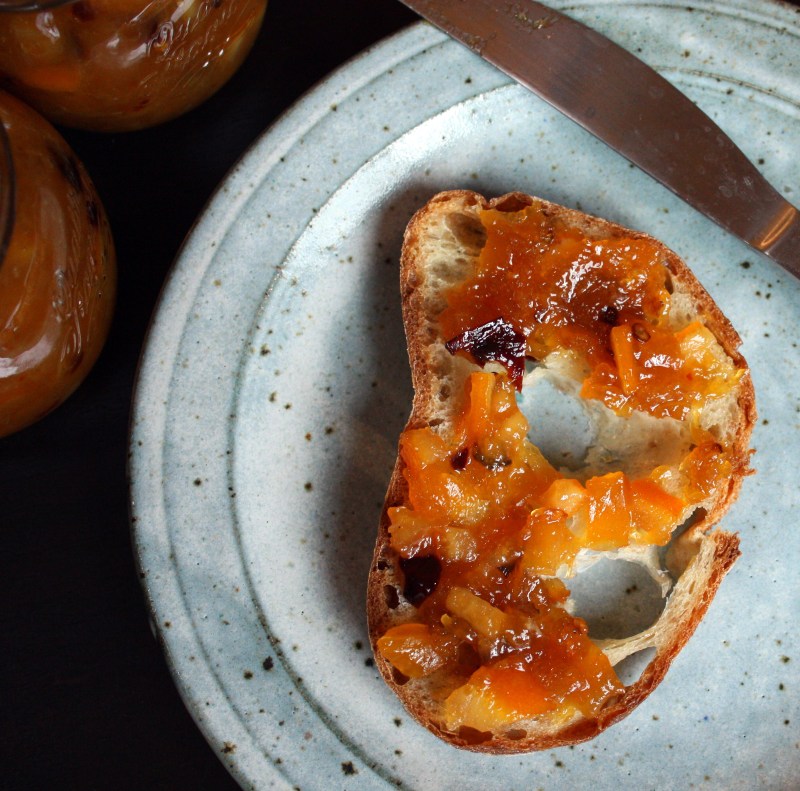 Can you believe that I still have a pumpkin from last Fall? Well, had a pumpkin, I should say. The vernal equinox, not to mention the 70+ temps this weekend, convinced me that it was finally time to say goodbye to the Last Fall Pumpkin, which has been gracing our countertop, courtesy of Fishkill Farm, since late October. So in celebration of the first day of Spring, I took my biggest knife to this 14 lb sucker and hacked it’s lovely, orange, tasty guts out.
Can you believe that I still have a pumpkin from last Fall? Well, had a pumpkin, I should say. The vernal equinox, not to mention the 70+ temps this weekend, convinced me that it was finally time to say goodbye to the Last Fall Pumpkin, which has been gracing our countertop, courtesy of Fishkill Farm, since late October. So in celebration of the first day of Spring, I took my biggest knife to this 14 lb sucker and hacked it’s lovely, orange, tasty guts out.
And that my friends, leads me to this long, convoluted geek-fest on the safety of canning pumpkin. There is math involved. And science. And more than a little rationalization. So if these things frighten you… step away. Skip to the end. Or go see what the Pioneer Woman is up to. Fair warning.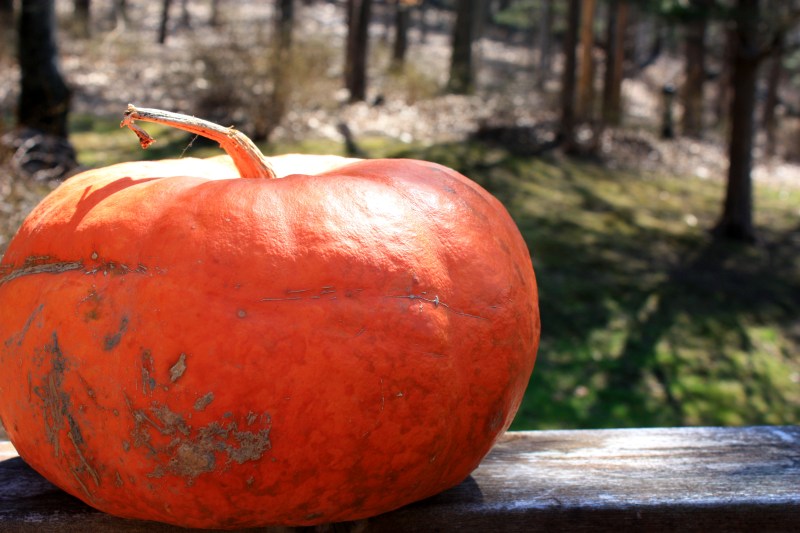
Last week the Tigress & I were having a little discussion about canning safety in general, and canning pumpkin safely in particular. As Tigress points out in her pumpkin marmalade post, the USDA is no friend of canned pumpkin. They say that you can pressure-can cubed pumpkin, but that there is no other safe method and/or recipe, including pumpkin puree, butter, jam, jelly, conserve or pickles. The USDA’s concern seems to focus mainly on pumpkin puree and butter, which can have a very viscous texture and therefore make it difficult/impossible for heat, in a home pressure canner or water bath, to penetrate to the center of the jar. Pumpkin being a low-acid vegetable (pH ranges from 4.8 – 5.2) the concern is understandable. But no pumpkin recipe is safe? How can pressure-canning of cubed pumpkin be safe, while, say shredded pumpkin in an acidic salsa isn’t safe? Why is the carrot (pH ranges from 4.9 – 5.2) safe to can in a variety of recipes, yet not the pumpkin? I understand the differences in density of the two vegetables, yet surely: a shred of pumpkin here and there in a salsa or chutney, a pumpkin jam, pumpkin sauce, pumpkin vingear? Something must be possible. And yet, when you look beyond the confines of the US of A, you do see pumpkin recipes. Canada offers us Mary Ann Dragan and her recipe for pumpkin marmalade. From France there is the world-famous Christine Ferber, renowned for her confitures, with recipes for pumpkin jam with vanilla and pumpkin with caramelized lemon. I somehow doubt that diners at Alaine Ducasse in NYC (who famously serves only Ferber’s preserves) are dropping like flies from botulism. So what gives? Why no pumpkin love from the USDA?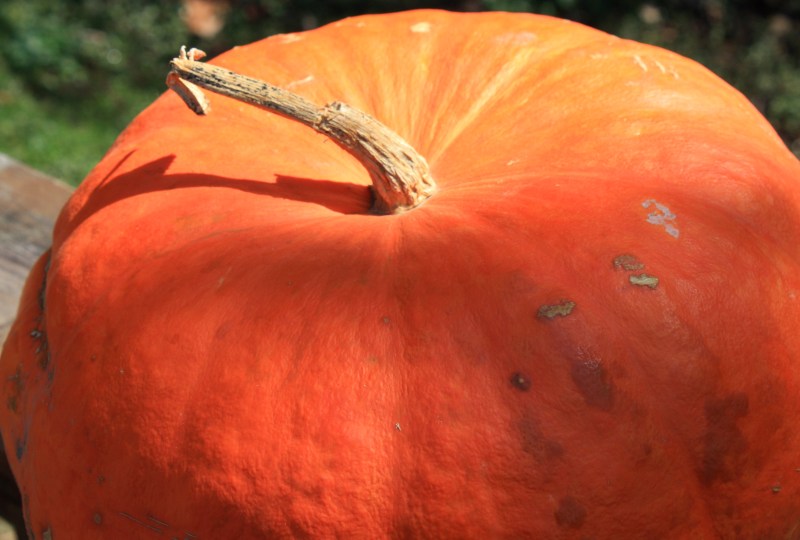
In my cantankerous way, I set out to can me some pumpkin, and to try to prove to myself, with the information I could dig up on Ye Olde Internets, that it was safe. Now, let me just say upfront that this is not a good idea. The first, best, and probably only reason I need to believe that the pumpkin marmalade recipe I decided to try was safe to can was the fact that it is a published recipe in a respected canner’s cookbook, one who specifically states that all the recipes in the book are safely acidic for water-bath canning. But, once I get my hands on some data, I can be a little stubborn. And I always prefer to work something out for myself than to take someone else’s word for it. So, let’s just do some math, shall we?
According to this paper, 15 mL of lemon juice was sufficient to acidify 100 g of onions to a pH below 4.0. According to this chart (Appendix I), the pH of onions ranges from 5.3 to 5.8, while the pH of pumpkin ranges from 4.8 to 5.2. So the pH of pumpkin is lower than that of onions, and it would take 150 mL of lemon juice to acidify 1000 grams of onions. The average lemon yields about 1/4 cup, or 60 mL, of juice, so the juice from two lemons would be about 120 mL. The additional acidity from an orange, the peels of the lemons, and the fact that pumpkins are slightly more acidic than onions, gives me the gut feeling that this recipe should be safe. But, to back up my guts with some data, let’s take a look at an approximate calculation of overall pH if we follow the recipe exactly. The pH of lemons ranges from 2.2 – 2.4 (lemon juice is 2.3) and the pH of oranges ranges from 3.1 – 4.1 (orange juice quoted at 3.6 – 4.3). Using the average mass of an orange (250 grams) and a lemon (175 grams), and a yield of about 2 and 1/4 lbs pumpkin flesh (1000 grams) from a 3 lb pumpkin, we can come up with a rough estimate of the pH contribution of the main recipe ingredients, and see if the total pH is below the safe pH of 4.6 for water bath canning. If we consider simple 100 gram increments of our marmalade mixture, we have:
- 1000 g pumpkin = 10 increments at 5.0 pH = 50
- 250 g orange = 2.5 increments at 3.6 pH = 9.0
- 350 g lemons = 3.5 increments at 2.3 pH = 8.05
- Total pH = (50 + 9 + 8.05)/16 total increments = 4.19
I did make some changes to the recipe: I only had one lemon in the house, but two oranges. To make up for the missing lemon, I added 1/4 cup of bottled lemon juice and the frozen zest from two lemons. To make sure there was enough peel in the marmalade, I added the extra orange. In addition, I added extra orange juice for a boost of orange flavor and acidity. I also decreased the amount of sugar, because most marmalades are much too sweet for me, and added some dried Cascabel peppers, because, I’m wacky like that (but the sugar and dried chiles should have no impact on the final pH). If we consider the version that I made, we get the following:
- 1000 g pumpkin = 10 X 5.0 pH
- 500 g oranges = 5 X 3.6 pH
- 185 g orange juice = 1.85 X 3.95 pH
- 175 g lemons = 1.75 X 2.3 pH
- 60 g lemon juice = 0.6 X 2.3 pH
- Total pH = (50 + 18 + 7.3 + 4.0 + 1.4)/19.2 = 4.20
If we consider the worst-case scenario, wherein you get massive yield out of your pumpkin, use teeny-tiny lemons & oranges, and everything is at the outside range of high pH, we get the following:
So, even the worst-case scenario turns out to be safe (albeit just barely so) for water-bath canning. Granted, I’ve made several assumptions here; I’ve assumed that all of the water (2 or 3 cups at pH of 7.0) is boiled off in the cooking process and therefore makes no contribution to overall pH; I’ve assumed that all elements of the marmalade will equilibrate and therefore the inside of a pumpkin chunk will be just as acidic as the surrounding jam; I’ve assumed that this is even a remotely reasonable way of approaching the estimation of final pH in a preserve, which it is probably not. So don’t listen to me. Make this pumpkin preserve because it is yummy, with a bright orange flavor, a subtle pumpkin note, and a hint of heat from the chiles. Can it because it is the tried & true recipe of a respected and published canner. Or don’t can it because the USDA tells us, for presumably good reason, that canning pumpkin isn’t safe. I’m not here to tell you what to do. I just like math.
Adapted from Pumpkin Marmalade by Tigress at Tigress in a Jam, via Well Preserved by Mary Ann Dragan
————————————————————–
INGREDIENTS
- 2 and 1/4 lbs pumpkin (1000 g), diced to 1/8 to 1/4-inch cubes (from a scant 3 lb pumpkin, peeled, seeded and stringy insides removed)
- 2 organic lemons (I used 1 whole lemon + 1/4 cup lemon juice and frozen zest from 2 lemons)
- 2 organic oranges
- 3/4 cup orange juice
- 2 cups water
- 2 and 1/2 cups sugar (turbinado)
- 4 dried cascabel chiles, with seeds, crushed (or other mild, smoky dried pepper)
- 1/4 tsp Kosher salt
METHODS
- Chop the pumpkin in half and scrape out seeds (save seeds for roasting) and cut pumpkin into sections. Trim the stringy insides, with a scoop, spoon, or a sharp knife, then peel each section with a vegetable peeler. Dice to 1/8 to 1/4-inch squares, being careful to keep the pieces as similar in size as possible (and don’t go larger than 1/4-inch). Set aside.
- Slice lemons and oranges. Slice each citrus fruit in half, along the middle between the stem & blossom end of the fruit. Give each half a gentle squeeze over a large, non-reactive stockpot, to minimize juice loss while slicing. Remove seeds and reserve in a small bowl. Slice off 1/4-inch of the stem end and discard. With the cut end flat on the cutting board, use a sharp, serrated knife to make thin, half-moon slices of fruit + peel. Then slice each half-moon into 4 – 8 pieces (depending on how big you like the pieces of peel in your marmalade). Scrape chopped citrus sections into the stockpot, being careful to add all the juice to the pot.
- Tie the seeds into a small square of cheesecloth (or use a stainless steel tea ball) with kitchen twine.
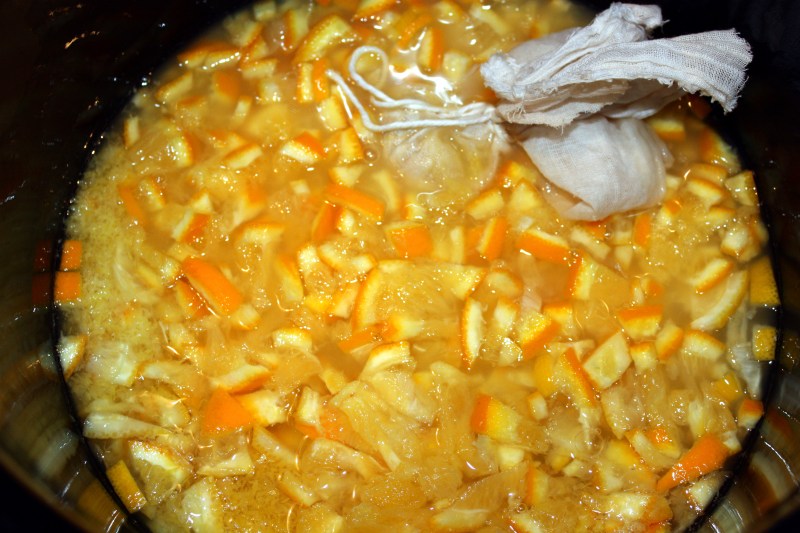
- If canning, prepare canner, jars and lids (see Options).
- Add lemons, oranges, orange juice, water, and seed pouch to stockpot. Bring to a boil, then lower heat and simmer for about 30 minutes, or until peels have softened.
- Add sugar. Allow to dissolve for approximately 5 minutes over low heat. Add pumpkin. Bring to a boil over high heat, and boil rapidly, stirring frequently, until mixture starts to reduce, about 15 – 20 minutes.
- Over a small bowl, crush Cascabel chiles in your fist until no pieces remain larger than 1/4-inch. Add chiles and salt to marmalade mixture. Continue to cook, stirring frequently (lower the heat if marmalade begins to stick or scorch), until the marmalade reaches the gel point: 220 degrees F (8 degrees F higher than the temperature of boiling water on your thermometer), or a dollop of marmalade placed frozen on a chilled plate for 1 minute wrinkles when pushed with a finger. The marmalade will thicken visibly and a spoon dragged across the bottom of the pan will leave an empty trail for 1 to 2 seconds. In total, my marmalade cooked for about 45 minutes.
- Fill hot, sterilized jars with hot marmalade to 1/2-inch headspace. Remove air bubbles, wipe rims, affix lids and process in a boiling water bath for 10 minutes OR simply cap and refrigerate.
Yields about 4 and 1/2 cups.
- As noted above, the original recipe calls for pumpkin, 2 lemons, 1 orange, 3 cups water and 4 cups of sugar, and of course, no chile pepper or salt.
- The marmalade tasted of orange more than anything else; it is quite good, but when I make it again I will use the two lemons and one orange stated in the orginal recipe. The pumpkin flavor is quite subtle (which may be because my pumpkin was so old) but may be brought out more if there is less orange in the mix.
- See above convoluted discussion about the safety (or lack thereof) of canning pumpkin. I believe this recipe is safe to can – but the USDA does not. They probably know more than me. Can at your own risk. If you will be canning, I strongly encourage you to weigh all of your ingredients; when in doubt, extra acidity (another lemon, or orange, or juice) is never a bad thing.
STORE
Canned, in a cool, dark spot for up to 1 year. Refrigerated, in sterilized jars, for 2 – 3 months. Frozen for up to 1 year.
SEASON
Um, Spring? 🙂 Pumpkins are available in farmer’s markets in Fall through Winter, and on into early Spring. Citrus is never in season in the Northeast, but where it grows, it is in season in mid- to late Winter.

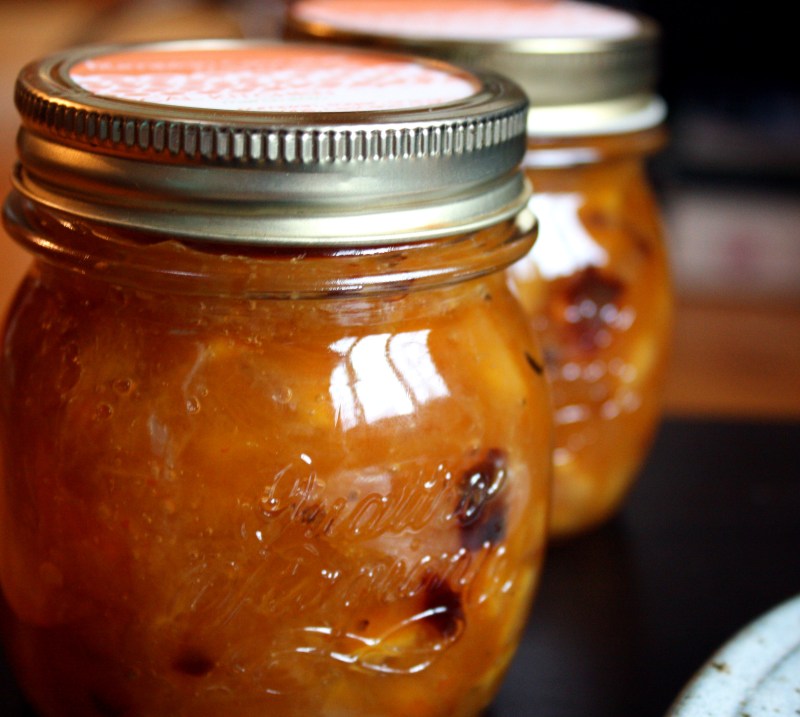
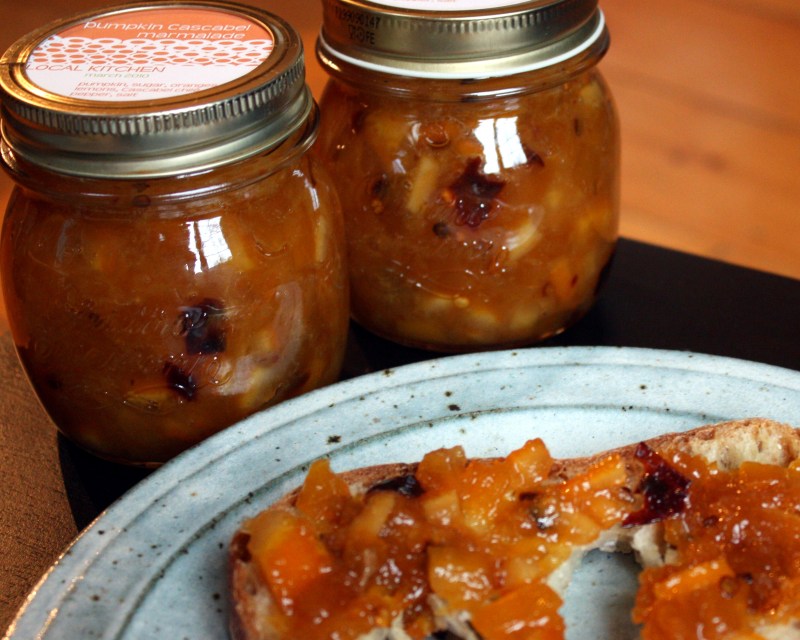
Very cool science and math!
I just steam or microwave my pumpkin, pack the cooked flesh in vacuum sealed bags, and freeze it.
As for why this country is trying to dissuade canning pumpkin, you might want to check how many ex-board members of Libby’s are employed by the USDA! (Just kidding, but I wouldn’t be surprised…)
great post! i am so jealous, i ate all mine already! i love this marmalade – with gobs of homemade butter on sourdough bread. i’m swooning over your photos. i’m canning mine next time.
…and i’m planting extra pumpkins this year! 🙂
Such a good post. How I’m loving learning more about canning. What is totally weird though, is how botulism is the same all over the world but how people preserve food varies. Sophie’s flippant comment that touches on the power of commercial companies shouldn’t be taken with a pinch of salt. I feel a feature film coming on with a canning theme, with perhaps Angelina J doing the canning.
Love the look of the marmalade.
Sophie – I agree, I usually just freeze pumpkin, either in chunks or in puree, but sometimes there is a pumpkin preserve that you just *want* to make, because it sounds delicious. And fridge space at my house is *always* at a premium! And interesting point about Libby – I hadn’t thought about that but you are probably right. Do you remember that “pumpkin pack scare” of last Fall, around Thanksgiving, that stores were going to run out of pumpkin pack for pies because of the bad pumpkin harvest? Apparently it was all a scam, orchestrated by Libby.
Tigress – I’ll try to save a jar for a PB cookie/melon/ marmalade party. I’ll have to hide it from Tai. 🙂
Gloria – I think sometimes the differences in canning practises can be related to the differences in local produce; the soil, the sun, the acidity in a certain region can produce big variations in the type of vegetable and the pH of that vegetable. So maybe in Alsace Christine Ferber always cans a particular type of pumpkin that has a normal pH of 4.7 or 4.8 and therefore doesn’t need much acidification, but here in the States our typical pumpkin is closer to 5.2; therein lies a problem. Which is why I started with a Canadian recipe; they are simply closer to home and there should be lesser variety in the types of produce that grow there. However, none of that should mean that there is no possible safe way to can pumpkin here in the States – to me that still seems just ridiculous.
Love the math! I’m not worried about the acidification as much as the heat transfer. I am wondering if there is a tested recipe for pumpkin chutney in the Ball Complete Book of Home Preserving? There are tons of non canning safe recipes in the Ferber book.
Hi MK,
The Ball Book has a recipe for Autumn Glory Compote, which includes 5 cups of cubed pumpkin (3/4-inch X 2 inch) as well as 5 cups of pineapple. They process in a water bath for 25 minutes. They also have a recipe for Sweet Pickled Pumpkins (same size cubes) in vinegar that they process for 20 minutes.
My thinking is with the small cubes (1/4 inch or less) heat penetration shouldn’t be a problem, even with only 10 minutes of processing time. I guess it wouldn’t hurt much to up it to 15 or 20 minutes.
As for the not-safe-for-canning recipes in the Ferber book; I guess that’s sort of my point. Some of them look non-safe to me, but if this is how she makes her jam, and never appears to process it, then how is it that no one is getting sick from Ferber jams? It’s not like she doesn’t sell quite a bit of them. I wonder if that the cookbook represents her recipes, but the jam for ‘production’ goes through a commercial processing step.
My approach to the Ferber book is to use it just for flavor ideas. I like her use of natural pectin, but I make mine this way:
http://motherskitchen.blogspot.com/2008/09/canning-jam-without-pectin.html
I couldn’t see canning apple jelly to then use it again canning jam later…too much work!
Oh my goodness, math and chem. That’s so awesome. And that marmalade looks tasty…never thought of pumpkin marmalade before.
Wow. This is such a hard core post, and I love it completely even though I got a little bit dizzy on the math. (I actually have a fondness for math, but it’s late for me and my eyes are tired.) I think it’s safe to can too, but I’m assuming the USDA have to err on the side of safety. It’s the American way. I always wondered at the Ferber recipes, and lack of processing, just because her jams are not just out of her patisserie anymore…
So, how did the Cascabel Marmalade taste after letting the flavors blend?
It sure looks great. But, flavor is everything. Would you describe it a mild heat, medium heat, or HOT? I know this is subjective but I would still like your opinion.
Thanks again, Jim in So Calif
I just tasted the marmalade last week; it is now quite pumpkiny and much less citrusy. Not overly sweet at all and the cascabel is quite mild. Overall I *really* like how it has aged over about 6 months. Next time I might just add a pinch or two of cayenne pepper for a wee bit more spice (I’d give it a mild to just-barely medium on the spicy scale).
I adore this post, love the math. I also can pumpkin butter. I am aware that it is not advised to do so according to the NSB. I do use my pressure canner to process my butter for commerical sale and I use lots of fresh tangerine juice as the seasons colide here in Florida. You know I have my trusty PH meter and I will be preparing pumpkin this week in our kitchen and calibrating the meter. I am very interested to see the PH result based on my recipe. Christine Ferber is my idol and I would not hesitate to use any of her published recipes for my own use. It is an interesting thought that the same fruits and vegetables could have different acidity levels depending on where they are grown in the world. 🙂
This was a very interesting article. I have canned for years and keep (I purchased through a drug store) litmus paper that will tell me if the ph of a recipe is 4.6 or lower. As 4.6 or lower is supposedly safe to water bath. On pumpkin viscosity; perhaps lemon juice to raise ph and then only can in pints or smaller jars. My punkins are just ripening in my garden, I think I will can them.
I just finished cleaning, cooking, and mashing my hallowe’en display, and I have 72 cups of mashed pumpkin. Only half of it fit in the freezer, so I need a few good Pumpkin canning recipes. I am an experienced canner, but I have never worked with pumpkin before (I usually stick to soups and pies).This recipe looks fantastic, but I did not weigh my pumpkins (I don’t actually have a scale) and I have already mashed it. What do you think would be approximately the equivalent amount of cooked, mashed (not packed) pumpkin for this recipe?
Hi Brittany,
Mashed pumpkin can’t really be safely canned at home; certainly not in a water bath process, and it isn’t even recommended for pressure canning, because the dense texture prevents full heat penetration to the middle of the jar.
If it is all mashed.. my only advice is to puree & strain out the juice (I usually cut the volume in half when I do that) and freeze the resulting thick puree, or spread the puree on dehydrator trays or dry in a low oven overnight to make pumpkin leather. You could add chunks to soups & stews over the winter, or you can add fruit pulp or juice now for sweet-savory fruit leathers.
O.K. this is like porn for the food/math geek in me! First I was going to ask if you thought holding back on some of the sugar and using orange juice concentrate to sweeten (killing two birds with one orange) the jam, but given the comment about it being ‘too much orange flavor’ have reconsidered. Thinking about adding some craisins or tart cherries, but for adding acid and not changing the flavor profile too much. What do you think about sour salt (citirc acid) as it is probably more quantifiable and more neutral in flavor? Is leaving the pumpkin stringy better for heat penetration than blending it? Right now mine is quite stringy so it is more like a marmalade whereas blending it might make it more like pumpkin butter…
I would like to make the Autumn Glory compote and am wondering if I can use sweet potatoes or another squash if pie pumpkin is not available. In fact, I cannot remember if I ever saw pie pumpkins for sale in my area of northern Illinois. Can I use canned pumpkin instead of fresh?
You definitely can NOT use sweet potato OR canned pumpkin. It is a consistency/density issue – the final product will not be safe to can in a water (or in a pressure canner, for that matter).
Other fresh winter squashes would be fine: you can find fresh butternut squash at most supermarkets.
First, let me thank you for sharing this recipe. It looks yummy and I plan to try it. But I am very concerned that you are fooling yourself and your readers with this “math.” You seem blithely unaware that the pH scale is logarithmic and you cannot average pHs in this manner. Also, even if you do take that into account and do the math correctly, you don’t know what is going on chemically (such as, does your pumpkin have buffer qualities that would affect the final pH? Probably). With the internet at your fingertips, why would you not look up how to calculate the pH of a mixture before attempting this?
I have been making pumpkin marmalade gor about 12 years now! No one has Ever gotten sick, ive never lost a jar to spoilage. Only A couple years ago I found out you’re not supposed to can pumpkin!! Since then , i ve turned to using litmus paper to test ALL MY SALSA, SAUCES, JAMS AND BUTTERS! This way i know I’m in the safety zone!